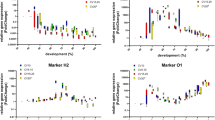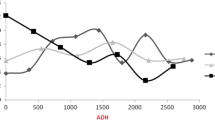Abstract
Estimating the post mortem interval (PMImin) by age determination of blow fly larvae has been well-established for moderate temperatures. Low-temperature developmental data is only available sparsely and usually does not take overwintering strategies into account. The blow fly Calliphora vicina hibernates by diapausing in the third larval stage extending the duration of this developmental stage up to several weeks or even months. As the diagnosis of the diapause status is not possible by morphological characteristics, PMImin estimations might be biased during the cold season if only based on age determination of third instar larvae of C. vicina. Molecular markers were searched for which allows one to identify diapause in larvae. Expression analysis of 19 genes was performed in diapausing and non-diapausing larvae. Three genes encoding for heat shock proteins (hsp23, hsp24 and hsp70) were found to be up-regulated distinctly in diapausing larvae and at 1 day in non-diapausing larvae. If several larvae are subjected to an analysis, a high variance in the expression level of the gene encoding for the anterior fat body protein is a further marker for diapause. The present study proves the potential use of gene expression analysis as a suitable diagnosis tool for diapause in C. vicina.





Similar content being viewed by others
References
Amendt J, Richards CS, Campobasso CP, Zehner R, Hall MJR (2011) Forensic entomology: applications and limitations. Forensic Sci Med Pathol 7:379–392
Fremdt H, Amendt J (2013) Species composition of forensically important blowflies (Diptera: Calliphoridae) and fleshflies (Diptera: Sarcophagidae) through space and time. Forensic Sci Int, submitted
Saunders DS, Macpherson JN, Cairncross KD (1986) Maternal and larval effects of photoperiod on the induction of larval diapause in two species of fly, Calliphora vicina and Lucilia sericata. Exp Biol 46:51–58
McWatters HG, Saunders DS (1998) Maternal temperature has different effects on the photoperiodic response and duration of larval diapause in blow fly (Calliphora vicina) strains collected at two latitudes. Physiol Entomol 23:369–375
Saunders DS (2000) Larval diapause duration and fat metabolism in three geographical strains of the blow fly, Calliphora vicina. J Insect Physiol 46:509–517
Saunders DS (1987) Maternal influence on the incidence and duration of larval diapause in Calliphora vicina. Physiol Entomol 12:331–338
Tarone AM, Jennings KC, Foran DR (2007) Aging blow fly eggs using gene expression: a feasibility study. J Forensic Sci 52:1350–1354
Tarone AM, Foran DR (2011) Gene expression during blow fly development: improving the precision of age estimates in forensic entomology. J Forensic Sci 56(Suppl 1):S112–S122
Boehme P, Spahn P, Amendt J, Zehner R (2013) Differential gene expression during metamorphosis: a promising approach for age estimation of forensically important Calliphora vicina pupae (Diptera: Calliphoridae). Int J Legal Med 127:243–249
Denlinger DL (2002) Regulation of diapause. Annu Rev Entomol 47:93–122
Flannagan RD, Tammariello SP, Joplin KH, Cikra-Ireland RA, Yocum GD, Denlinger DL (1998) Diapause-specific gene expression in pupae of the flesh fly Sarcophaga crassipalpis. Proc Natl Acad Sci U S A 95:5616–5620
Tachibana SI, Numata H, Goto SG (2005) Gene expression of heat-shock proteins (Hsp23, Hsp70 and Hsp90) during and after larval diapause in the blow fly Lucilia sericata. J Insect Physiol 51:641–647
Yocum GD, Joplin KH, Denlinger DL (1998) Upregulation of a 23 kDa small heat shock protein transcript during pupal diapause in the flesh fly, Sarcophaga crassipalpis. Insect Biochem Mol Biol 28:677–682
Rinehart JP, Yocum GD, Denlinger DL (2000) Developmental upregulation of inducible hsp70 transcripts, but not the cognate form, during pupal diapause in the flesh fly, Sarcophaga crassipalpis. Insect Biochem Mol Biol 30:515–521
Concha C, Edman RM, Belikoff EJ, Schiemann AH, Carey B, Scott MJ (2012) Organization and expression of the Australian sheep blowfly (Lucilia cuprina) hsp23, hsp24, hsp70 and hsp83 genes. Insect Mol Biol 21:169–180
Muguruma F, Goto SG, Numata H, Shiga S (2010) Effect of photoperiod on clock gene expression and subcellular distribution of PERIOD in the circadian clock neurons of the blow fly Protophormia terraenovae. Cell Tissue Res 340:497–507
Fremdt H, Szpila K, Huijbregts J, Lindström A, Zehner R, Amendt J (2012) Lucilia silvarum Meigen, 1826 (Diptera: Calliphoridae)—a new species of interest for forensic entomology in Europe. Forensic Sci Int 222:335–339
Naumann U, Scheller K (1991) Complete cDNA and gene sequence of the developmentally regulated arylphorin of Calliphora vicina and its homology to insect hemolymph proteins and arthropod hemocyanins. Biochem Biophys Res Commun 177:963–972
Hansen IA, Gutsmann V, Meyer SR, Scheller K (2003) Functional dissection of the hexamerin receptor and its ligand arylphorin in the blowfly Calliphora vicina. Insect Mol Biol 12:427–432
Development Core Team R (2012) R: a language and environment for statistical computing. R Foundation for Statistical Computing, Vienna
Saunders DS, Wheeler I, Kerr A (1999) Survival and reproduction of small blow flies (Calliphora vicina; Diptera: Calliphoridae) produced in severely overcrowded short-day larval cultures. Eur J Entomol 96:19–22
Saunders DS, Cymborowski B (2003) Selection for high diapause incidence in blow flies (Calliphora vicina) maintained under long days increases the maternal critical daylength: some consequences for the photoperiodic clock. J Insect Physiol 49:777–784
Saunders DS (1997) Under-sized larvae from short-day adults of the blow fly, Calliphora vicina, side-step the diapause programme. Physiol Entomol 22:249–255
Meuti ME, Denlinger DL (2013) Evolutionary links between circadian clocks and photoperiodic diapause in insects. Integr Comp Biol 53:131–143
Han B, Denlinger DL (2009) Length variation in a specific region of the period gene correlates with differences in pupal diapause incidence in the flesh fly, Sarcophaga bullata. J Insect Physiol 55:415–418
Rinehart JP, Cikra-Ireland RA, Flannagan RD, Denlinger DL (2001) Expression of ecdysone receptor is unaffected by pupal diapause in the flesh fly, Sarcophaga crassipalpis, while its dimerization partner, USP, is downregulated. J Insect Physiol 47:915–921
Hayward SAL, Pavlides SC, Tammariello SP, Rinehart JP, Denlinger DL (2005) Temporal expression patterns of diapause-associated genes in flesh fly pupae from the onset of diapause through post-diapause quiescence. J Insect Physiol 51:631–640
Rodriguez-Gabriel MA, Remacha M, Ballesta JP (1998) Phosphorylation of ribosomal protein P0 is not essential for ribosome function but can affect translation. Biochemistry 37:16620–16626
Yacoub A, Kelley MR, Deutsch WA (1996) Drosophila ribosomal protein P0 contains apurinic/apyrimidinic endonuclease activiy. Nucleic Acids Res 24:4298–4303
Craig TL, Denlinger DL (2000) Sequence and transcription patterns of 60S ribosomal protein P0, a diapause-regulated AP endonuclease in the flesh fly, Sarcophaga crassipalpis. Gene 255:381–388
Goto SG, Denlinger DL (2002) Short-day and long-day expression patterns of genes involved in the flesh fly clock mechanism: period, timeless, cycle and cryptochrome. J Insect Physiol 48:803–816
Amendt J, Campobasso CP, Gaudry E, Reiter C, LeBlanc HN, Hall MJR (2007) Best practice in forensic entomology—standards and guidelines. Int J Legal Med 121:90–104
Marchenko MI (2001) Medicolegal relevance of cadaver entomofauna for the determination of the time of death. Forensic Sci Int 120:89–109
Reiter C (1984) Growth behavior of the blue blowfly Calliphora vicina maggots. Z Rechtsmed 91:295–308
Hwang C, Turner BD (2005) Spatial and temporal variability of necrophagous Diptera from urban to rural areas. Med Vet Entomol 19:379–391
Acknowledgments
We thank Friederike Häuser and Petra Böhme for their support in PCR primer design. David Denlinger kindly provided primer sequences of PCNA. Natalie Filmann (Institute of Biostatistics and Mathematical Modelling, JWG-University, Frankfurt a.M.) is acknowledged for checking the statistical analysis and Kirsty Griffin for correcting the language of the manuscript. Finally, we thank two anonymous reviewers for their helpful and critical comments improving the quality of the manuscript.
Author information
Authors and Affiliations
Corresponding author
Additional information
Submitted to: International Journal of Legal Medicine
Electronic supplementary material
Below is the link to the electronic supplementary material.
ESM 1
(PDF 104 kb)
Rights and permissions
About this article
Cite this article
Fremdt, H., Amendt, J. & Zehner, R. Diapause-specific gene expression in Calliphora vicina (Diptera: Calliphoridae)—a useful diagnostic tool for forensic entomology. Int J Legal Med 128, 1001–1011 (2014). https://doi.org/10.1007/s00414-013-0920-x
Received:
Accepted:
Published:
Issue Date:
DOI: https://doi.org/10.1007/s00414-013-0920-x




